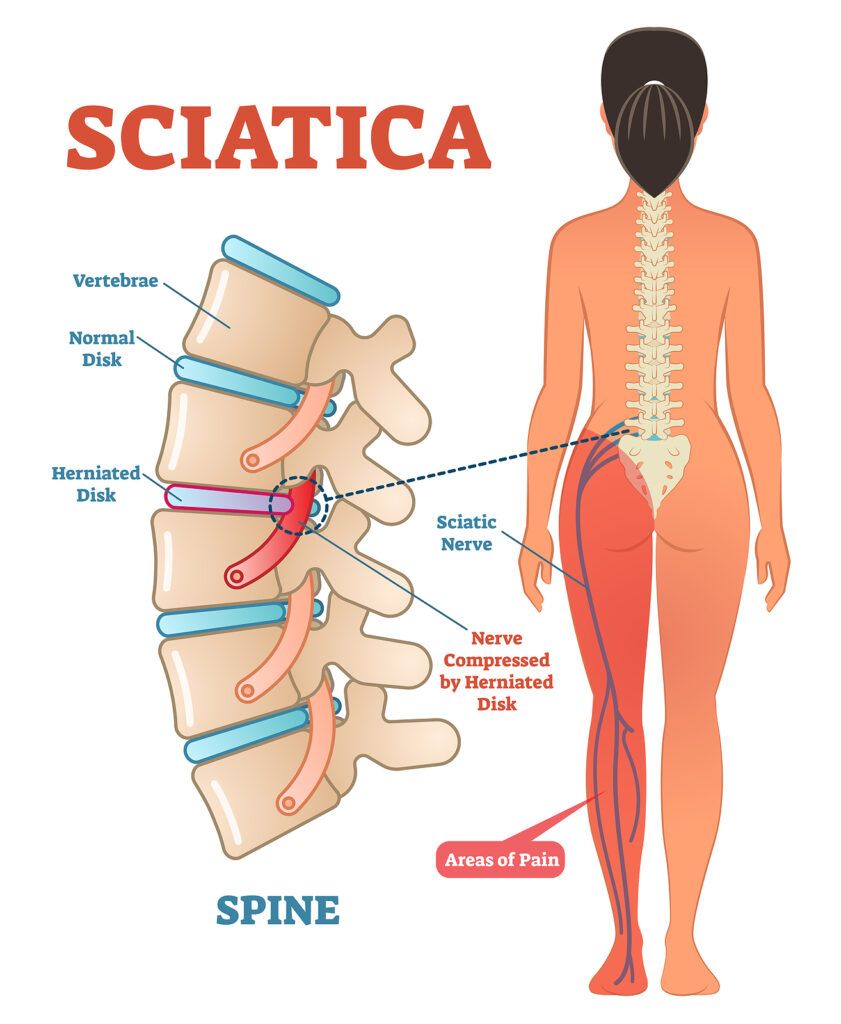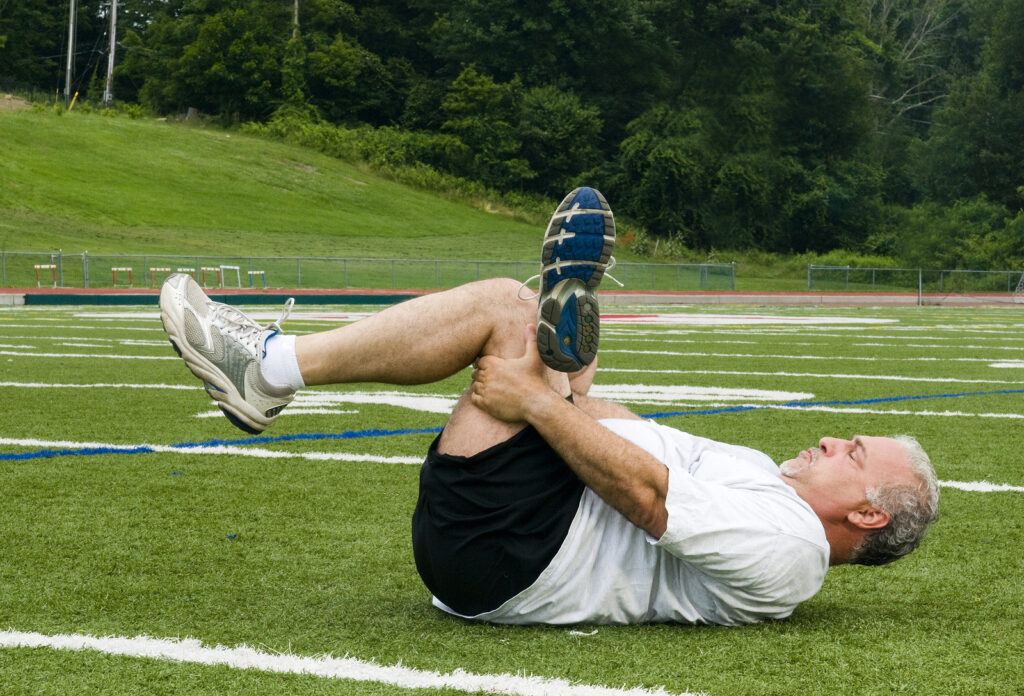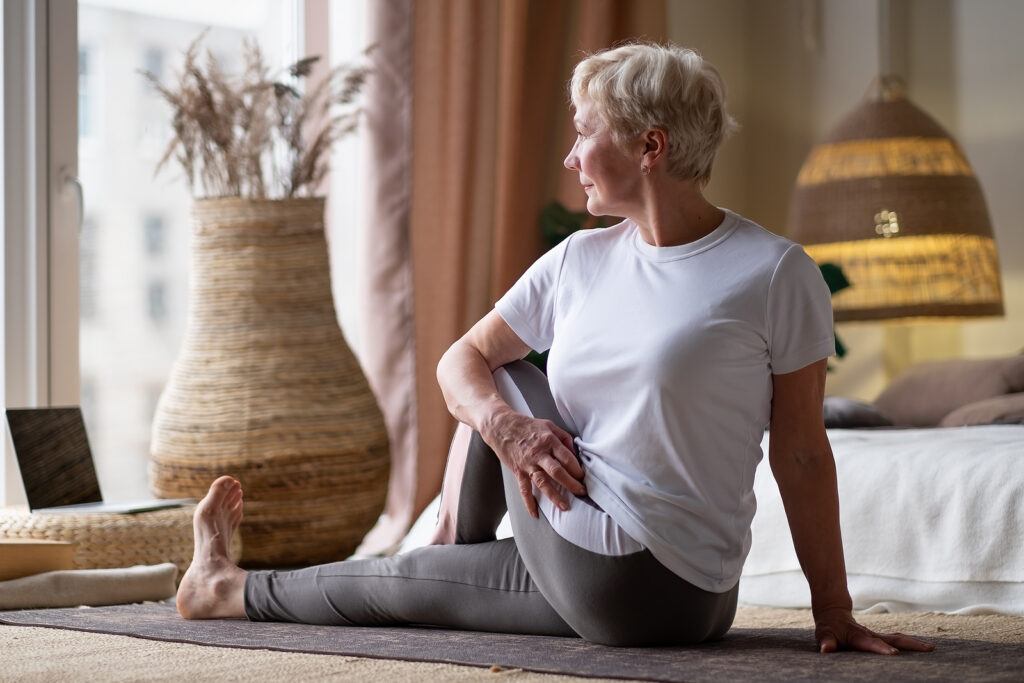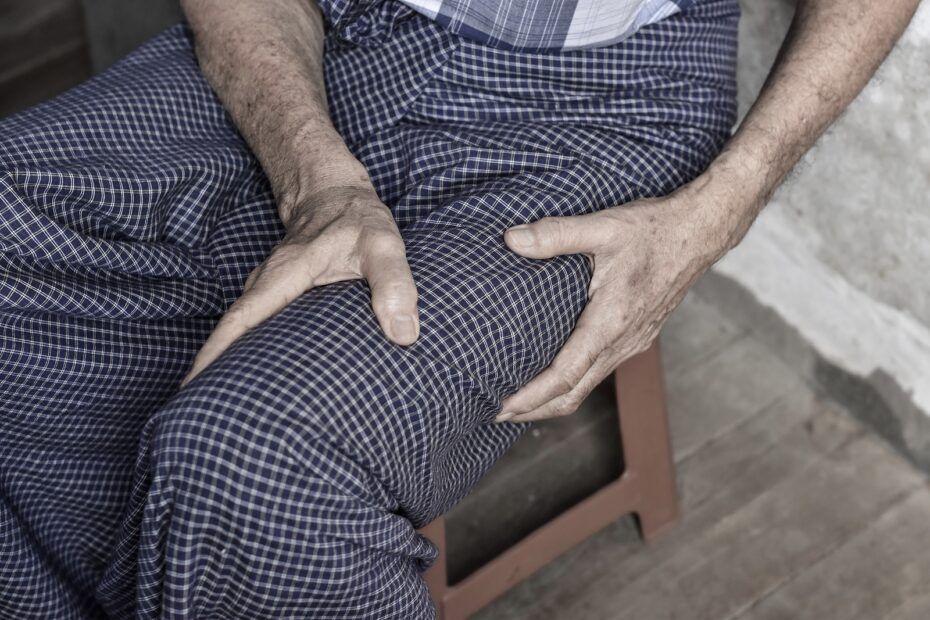Sciatica is a painful condition that affects adults of all ages, causing pain that radiates from the lower back down the leg.
It’s more common in seniors though and can be quite debilitating.
This pain is the result of irritation or compression of the sciatic nerve, the largest nerve in the body, which runs from the lower spine through the hips and down each leg.
The discomfort can range from mild to severe and can interfere with daily activities, making it difficult to walk, sit, or even sleep comfortably.
Fortunately, there are conservative measures seniors can take to get their symptoms under control.
Specific exercises can help relieve sciatica pain and improve mobility for seniors.
In this article, we’ll explore the best senior-friendly exercises that are gentle yet effective in easing discomfort from sciatica.
Let’s start with a quick rundown on what causes sciatica in the first place though.
What Causes Sciatica?
Sciatica occurs when the sciatic nerve becomes irritated or compressed.
Now this is a very large nerve and irritation anywhere along its route can cause sciatica-like symptoms.
Speaking of which, these symptoms can vary a little from senior to senior, but usually include:
- Pain starting at the back of one hip and radiating down the back of your leg
- Tingling or “pins and needles” in one leg
- Numbness
- Weakness
- Generalized aching in low back, hips, or down one leg
Again, irritation anywhere along the sciatic nerve’s route can lead to the characteristic pain, tingling, or numbness associated with sciatica.
However, here are the most common causes:
1. Herniated or Bulging Disc
According to the National Institute of Health (NIH), the most common cause of sciatica is a herniated or bulging disc in the spine.
The discs act as cushions between the vertebrae, but with age, they can weaken or become damaged.
When this happens, the gelatinous inner part of the disc can rupture through the tougher, outer portion and cause problems.
And when the disc pushes out of its normal space (herniation), it can press against the sciatic nerve, causing pain that radiates down the leg.
With a bulging disc, the disc simply pushes out from its normal resting space, but doesn’t actually rupture.
Both conditions can lead to sciatic symptoms though.

2. Spinal Stenosis
Spinal stenosis is a condition that results from the narrowing of the spinal canal, putting pressure on the nerves, including the sciatic nerve.
This narrowing can be caused by arthritis, bone spurs, or other age-related changes in the spine.
Sciatica caused by spinal stenosis tends to be more common in older adults.
3. Degenerative Disc Disease
As we age, the discs in our spine can degenerate, losing their flexibility and ability to absorb shock.
When the discs become too thin or damaged, the vertebrae can compress, irritating the sciatic nerve.
Degenerative disc disease is another age-related cause of sciatica and it’s very closely related to osteoarthritis.
4. Piriformis Syndrome
The piriformis muscle, located in the buttocks, sits near the sciatic nerve.
If this muscle becomes tight or spasms, it can irritate or compress the sciatic nerve, leading to pain.
This condition, known as piriformis syndrome, can mimic sciatica symptoms and is often related to muscle imbalances or overuse.
Fortunately, this issue is often treatable with exercise.
5. Spondylolisthesis
Spondylolisthesis occurs when one vertebra slips forward over another, narrowing the space where the nerves exit the spine.
And if this happens in the lumbar region, it can potentially affect the sciatic nerve, leading to sciatica.
This condition may be caused by spinal degeneration, fractures, or injury.
Treatment can include use of medications, physical therapy, and bracing with surgery usually being reserved for more extreme cases.
Why Exercise Is Important for Sciatica Relief
When dealing with sciatica, rest alone won’t always solve the problem.
While it’s important to avoid activities that worsen the pain, staying active is necessary. Exercise plays a key role in:
- Strengthening the Core and Lower Back: Strengthening the muscles around the spine and core can reduce pressure on the sciatic nerve and provide better support to your lower back.
- Improving Flexibility: Stretching helps loosen tight muscles, especially in the hips, hamstrings, and lower back, which can ease nerve compression.
- Boosting Circulation: Gentle movement increases blood flow to the affected areas, helping to speed up healing and reduce inflammation.
- Promoting Better Posture: Certain exercises help correct posture, preventing further irritation of the sciatic nerve.
Exercise is important, but we’re talking about specific, guided exercise like the ones mentioned in this guide.
Ignoring your pain and trying to push through with your normal routine is a bad idea when experiencing sciatic symptoms.
And when in doubt, always consult with your physician or physical therapist for professional treatment.
Safety Tips for Exercising with Sciatica
- Start Slowly: Begin with gentle exercises and stretches, especially if you’re new to exercising or if the pain is severe.
- Listen to Your Body: Avoid any movements that cause sharp or increased pain. You should feel a stretch, but it should never be painful or create worsened pain that lasts for days.
- Use Support When Needed: Consider using props such as pillows or rolled-up towels to support your body and modify exercises to suit your comfort level.
- Stay Consistent: For long-term relief, consistency is key. Exercising can sometimes offer fast relief, but it usually takes a little longer to see lasting results.
8 Effective Sciatica Exercises for Seniors
Here are some gentle, effective exercises and stretches specifically designed to help seniors manage and relieve sciatica pain.

1. Lying Figure-4 Stretch
This is a great exercise to stretch out a tight piriformis muscle and relieve pressure from that sciatic nerve.
This variation is meant to be done while lying on your back, so you’ll need room to comfortably do this (the bed or couch can work great).
- While lying on your back, bend one knee up (keep foot planted on bed) and place the opposite foot across that knee, making a figure-4 shape with your leg
- Depending on your tightness, you may feel a stretch in this position, but for additional stretch, grab below the planted knee and gently pull toward your chest
- You should feel a stretch in the back of your hip (the one crossed)
- Hold for 20-30 seconds and then switch to the other side
- Repeat 3-4x on each leg, 2-3x per day
2. Lying Piriformis Stretch (Knee to Opposite Shoulder)
This is another effective piriformis stretch and it’s a good alternative for seniors who have a hard time bringing their leg off the bed during the figure-4 stretch mentioned above.
- While lying on your back, bend one knee up (keep foot planted on bed) and place the opposite foot across that knee, making a figure-4 shape with your leg
- From here, gently pull the crossed knee toward the opposite shoulder (without moving the planted leg)
- You should feel the stretch in the back of your hip
- Hold for 20-30 seconds and repeat 3-4x for each leg
You can do this stretch without putting yourself in the figure-4 position first, but some seniors may feel a pinch in the front of their hip during this one.
Putting yourself in the figure-4 position first helps eliminate that pinching sensation.
3. Lying Hamstring Stretch
We’re going to give the piriformis a break and switch over to the hamstrings.
Tight hamstrings can cause a lot of different problems, but back/hip pain is one of the most common (so it’s a good idea to stretch those hammies whether you’re having pain now or not!)
There are a ton of different ways to stretch the hamstrings, but this variation is nice because you can do it comfortably in bed while performing the above stretches.
- From a lying position, bend one knee up toward your chest to a 90 deg position
- Grab behind this knee and gently straighten your leg up toward the ceiling
- You should feel a stretch in the back of your thigh
- Hold for 20-30 seconds and then switch legs
- Repeat 3-4x for each leg, 2-3x per day
4. Lateral Trunk Rotations
This is a great exercise for low back pain, hip pain, or generalized stiffness/achiness anywhere in that area.
This gentle stretch is great for getting everything in the low back moving and it can help reduce muscle tightness too.
It’s also often comfortable to do, even for really achy backs.
- From a lying position, bend both knees up while keeping your feet planted on the bed
- Keeping your knees together, gently rock your knees from side to side as far as they will comfortably go
- Repeat 10-15x to each side
This exercise can be beneficial for stretching out tight lumbar muscles and reducing strain on the sciatic nerve.
5. Seated Figure-4 Stretch
This is the seated version of the stretch mentioned earlier and it can be a great alternative for seniors who struggle with getting into the lying position.
It also makes it easier to hold the position, especially for seniors with shoulder or hand discomfort.
- Sit tall in a chair and cross your right ankle over your left knee, creating a figure-4 shape with your legs
- Gently press down on the right knee to deepen the stretch, feeling it in the back of your right hip
- Hold for 20-30 seconds, then switch sides
- Repeat 3-4x for each leg, up to 2-3x daily
6. Seated Hamstring Stretch
As mentioned, there are a lot of different ways to stretch the hamstrings out. This seated version is a good alternative for folks with mobility issues or who simply find this position more comfortable.
- Sit on a sturdy chair with both feet flat on the floor
- Extend one leg straight out with your heel on the floor and your toes pointing upward
- Keeping your back straight, slowly lean forward from your hips until you feel a stretch in the back of your thigh
- Hold for 20-30 seconds, then switch legs
- Repeat 3-4x on each leg, 2-3x per day
If you don’t feel much stretch with this one (or find it uncomfortable to lean forward), you can increase the stretch by performing with your leg up on an ottoman or stool.

7. Seated Trunk Rotations
This exercise is basically the seated version of the lateral trunk rotations mentioned earlier.
The seated position tends to get the thoracic spine a little more involved, but it’ll still mobilize the lumbar spine as well.
- Sit tall in a chair with your feet flat on the floor
- Slowly twist your upper body to the right, placing your left hand on the outside of your right thigh for support
- Hold for 10-20 seconds, then slowly return to the center and switch sides
- Repeat 5x for each side, up to 2-3x per day
8. Posterior Pelvic Tilts
Pelvic tilts are an introduction to core strengthening, which can help support the lumbar spine and pelvis and improve posture.
And any time you’re dealing with lumbar pain, core strengthening is a good idea.
- Lie on your back with your knees bent and feet flat on the bed
- Tighten your abdominal muscles and flatten your lower back against the bed
- Hold this position for 5 seconds, then relax.
- Repeat 10-15x
This exercise activates your core muscles, but it can also put your lumbar spine in a more natural position (for folks with an excessive lordosis).
If you’re new to pelvic tilts, it can be helpful to start by doing them on your back, but you can also progress to doing this exercise from a seated or standing position.
Incorporating These Exercises into Your Routine
For best results, perform these exercises consistently – ideally daily or even 2-3x per day, depending on how they feel.
They can be done in the comfort of your home, and you can gradually increase the duration and intensity as your strength and flexibility improve.
You can also combine these exercises with other low-impact activities like walking or swimming to further support your sciatic health.
That said, try to avoid activities that increase your pain.
Speaking of pain, you shouldn’t feel any increased pain while doing the above exercises – if you do, please adjust or stop that specific exercise all together.
It’s ok to feel a little stretching discomfort during the above exercises, but sharp or lasting pain after the exercise is done should be avoided.
When to Seek Medical Advice
If your sciatica symptoms persist or worsen despite exercise, it may be time to consult a healthcare professional.
Physical therapy or other medical interventions might be necessary for more severe cases of sciatica.
Always prioritize safety and avoid pushing through severe pain.
If your pain is making it hard for you to get around your home or is making you feel less confident on your feet, please consult with your physician.
Again, safety is the number one priority here.
Final Thoughts
Sciatica can be a frustrating and painful condition, but I promise you it isn’t the end of the world – with the right exercises, seniors can often manage their symptoms and improve their mobility.
The key is usually to stretch out and then strengthen the muscles around the lumbar spine and hips.
More specifically, we’re talking about the:
- Piriformis and glutes
- Hamstrings
- Lumbar paraspinals
I didn’t include any in the list above, but depending on the cause of your sciatica, stretching the hip flexors can also be quite beneficial.
It would also be a good idea to include some core strengthening exercises into your routine, but that’s a story for another day.
Remember, always consult your healthcare provider if you have any concerns before starting a new exercise program.
And never try anything you’re not comfortable with.
Anyway, I hope you found this guide helpful.
If you have any questions/comments or know of any great senior-friendly sciatica exercises that deserve a spot on this list, please leave ’em below and I’ll get back to you soon.




Where can I buy a DVD for back pain and sciatica exercises for seniors?
I’ve had several physical therapy sessions, but they don’t give out printouts of the exercises to do at home. A DVD for active seniors would be helpful.
I’m sorry to hear you didn’t get any printouts from your previous PT sessions, it would’ve been nice if they’d provided those so you could continue stretching on your own. I don’t have any experience with any DVDs for sciatica relief, but I did a quick search on Amazon and found this video that has pretty good reviews. Just a heads up – it looks like it was created by a personal trainer and not a physical therapist, so if you do try it, take caution and don’t do any exercises you don’t feel comfortable with. Also, I haven’t tried this personally, so I can’t vouch for the exercises being used. If you try it, I’d love to hear what you think though.